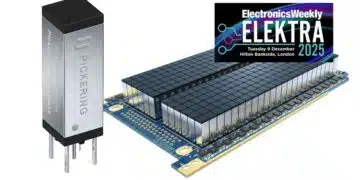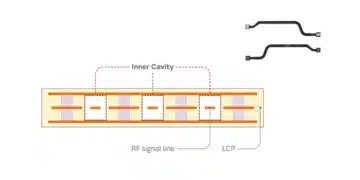source: Linkoping University news
Researchers at the Laboratory of Organic Electronics have developed the world’s first complementary electrochemical logic circuits that can function stably for long periods in water. This is a highly significant breakthrough in the development of bioelectronics.
Complementary featured logic circuit Photo credit: Thor Balkhed
The first printable organic electrochemical transistors were presented by researchers at LiU as early as 2002, and research since then has progressed rapidly. Several organic electronic components, such as light-emitting diodes and electrochromic displays, are already commercially available.
The dominating material used until now has been PEDOT:PSS, which is a p-type material, in which the charge carriers are holes. In order to construct effective electron components, a complementary material, n-type, is required, in which the charge carriers are electrons.
It has been difficult to find a sufficiently stable polymer material, one that can operate in water media and in which the long polymer chains can sustain high current when the material is doped.N-type material
In an article in the prestigious scientific journal Advanced Materials, Simone Fabiano, head of research in the Organic Nanoelectronics group at the Laboratory of Organic Electronics, presents, together with his colleagues, results from an n-type conducting material in which the ladder-type structure of the polymer backbone favours ambient stability and high current when doped. One example is BBL, poly(benzimidazobenzophenanthroline), a material often used in solar cell research.
Postdoctoral researcher Hengda Sun has found a method to create thick films of the material. The thicker the film, the greater the conductivity.
“We have used spray-coating to produce films up to 200 nm thick. These can reach extremely high conductivities,” says Simone Fabiano.
The method can also be successfully used together with printed electronics across large surfaces.
Hengda Sun has also shown that the circuits function for long periods, both in the presence of oxygen and water.Moist surroundings
“This may appear at first glance to be a small advance in a specialised field, but what is great about it is that it has major consequences for many applications. We can now construct complementary logic circuits – inverters, sensors and other components – that function in moist surroundings,” says Simone Fabiano.
“Resistors are needed in logical circuits that are based solely on p-type electrochemical transistors. These are rather bulky, and this limits the applications that can be achieved. With an n-type material in our toolbox, we can produce complementary circuits that occupy the available space much more efficiently, since resistors are no longer required in the logical circuits,” says Magnus Berggren, professor of organic electronics and head of the Laboratory for Organic Electronics.
Applications of the organic components include logic circuits that can be printed on textile or paper, various types of cheap sensor, non-rigid and flexible displays, and – not least – the huge field of bioelectronics. Polymers that conduct both ions and electrons are the bridge needed between the ion-conducting systems in the body and the electronic components of, for example, sensors.
The article: Complementary logic circuits based on high-performance n-type organic electrochemical transistor, Hengda Sun, Mikhail Vagin, Suhao Wang, Xavier Crispin, Robert Forchheimer, Magnus Berggren, Simone Fabiano, Advanced Materials 2017. DOI: 10.1002/ adma.201704916R2
































